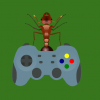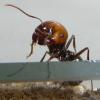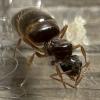It should be considered that pathogens and viruses that are carried by one species are not always isolated to a single species. For example, Kneallhazia solenopsae J.D.Knell, G.E.Allen & E.I.Hazard, 1977, known as the Solenopsis invicta Virus 1 (SINV-1), is primarily carried by S. invicta, but has been found in multiple native species, S. ritcheri, and two Solenopsis hybrids (Ascunce et. al., 2010; OI, D.H. & Valles, S.M., 2012; Valles, S.M., 2012). There is a longer known history of this ssRNA virus being known in native species for longer then the cited publications.
While there may not be significant damage from this one virus, there is a lack of studies to ever be able to say if it played a role in nearly extirpitating species such as S. xyloni from the South*. This could be tested by testing preserved species of Solenopsis spp. collected through time to see when the virus spread through the native species and compare to the expansion of S. invicta in the USA. To spread a pathogen the smart way, it would require rather costly studies on if the pathogen could be passed on or carried by natives species. If one or more species were found to be potential carriers, it would then need to be followed by studies on the effects of the pathogen on native species. Without such studies, you will singlehandedly be potentially threatening the well being of native species. With that said, there are biopesticides that only affect a species and closely related species. However, these biopesticides generally take decades to develop. The US actually has a devoted USDA researcher, Dr. Robert K. Vander Meer, who has spent decades in search of formulating a solution to the S. invicta issue. If there's any one to contact about the issue and management of the species, it's him.
*Off-topic side note about the S. xyloni from the South. It was found to be a different species to Western S. xyloni. The former Western form, S. maniosa, thus has its validity re-questioned. This means that the aforementioned virus could have played a role in extirpating "true" S. xyloni from >75% of its historic range.
Edited by ReignofRage, May 28 2024 - 12:45 PM.





















